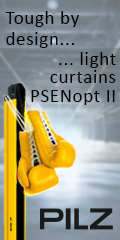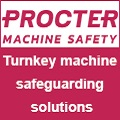
Posted to News on 22nd Nov 2006, 20:24
Pros and cons of alternative linear actuator technologies
In this technical article Paul Seale, Regional Sales Manager for the Electromechanical Division of Parker Hannifin, examines some of the recent developments in linear actuator technology.
Linear actuator technology is used extensively throughout industry for moving, positioning, clamping and guiding components, assemblies, finished products and tooling mechanisms. Typical applications range from materials handling and gantry systems to food processing and packaging lines, and from electronics pick-and-place equipment to test instruments and scanners used in the medical sector.
The growing need to improve productivity, reduce operating overheads and automate previously manual processes has led to the introduction of products that are faster, smaller and more cost-effective than ever before. In particular, the launch of compact, lightweight and more robust and reliable linear actuators, along with the introduction of packaged or integrated systems, is enabling OEMs and end users alike to benefit from quicker specification, installation and setup, reduced maintenance requirements, longer product life and enhanced system performance.
Although there are various types of linear actuator, the simplest are those constructed from a slide mechanism on which a carriage is mounted. This effectively acts as a platform on which the workpiece or operating mechanism can be fixed and normally moves by means of rollers, bearings or wheels, often contained in a raceway.
The slide mechanism is driven either indirectly from a separate motor via a belt or screw mechanism and appropriate gearing, or directly by means of a linear motor that is integrated into the body of the actuator.
Pros and cons
Each of these drive methods offers a number of advantages in different applications. For example, belt drives are generally simple, low-cost devices that can provide a high level of speed and acceleration, but are limited in terms of accuracy; screw drives offer excellent stiffness with a reasonable combination of precision and resolution. In comparison, systems incorporating linear motors are extremely precise, deliver high speed and acceleration, are virtually maintenance-free and have a long operating life.
Regardless of the drive mechanism, the adaptable nature of linear actuators enables them to be used in either a standard or modified form in a wide range of plant and machinery. Perhaps more importantly, in today's economic conditions where high levels of productivity and low unit costs often depend on factors such as machine speed and precision, it is possible to manufacture high-performance units that are easy to incorporate into existing production lines and that offer a number of crucial operating advantages.
Belt-driven benefits
These belt-drive actuators are capable of moving at speeds of up to 5m/s, and can support loads of 1600kg with a thrust force of over 5000N, yet offer levels of repeatability that are within +/-0.05mm. In addition, the ability to use either synthetic load bearing wheels running in high-precision anodised aluminium profiles, or hardened steel wheels, lubricated for life, running on steel guideways to support the load bearing carriage, means that these products can be used both in specialised cleanroom or test/inspection applications, as well as in heavy-duty systems such as in gantry robots, materials handling and palletising.
Although belt, rack-and-pinion and screw-driven linear actuators offer a wide range of benefits in many industrial applications, they are ultimately limited by the mechanical performance of the drive components.
Linear motors offer more
For high-performance systems, especially those requiring rapid acceleration and extremely high levels of positional accuracy and repeatability, the alternative is to use a linear motor. In essence, this is a rotary servomotor rolled out flat, with the rotor becoming a forcer, incorporated within the carriage, and the stator magnets forming the guide rail along which the carriage runs. In systems such as Parker's BLMA linear motor, the motor windings are arranged on either side of a continuous raised strip of permanent magnets, ensuring that the electromagnetic forces act evenly and efficiently across the actuator. The carriage assembly is supported on low-noise synthetic rollers or metal bearings.
This configuration has a number of important benefits over conventional belt-and-pulley, rack-and-pinion and screw-driven systems. In particular, it is possible to achieve exceptionally high levels of acceleration and speed, typically up to 50m/s2 and 10m/sec respectively, with excellent repeatability of with +/-0.1um. Additionally, linear motors do not suffer from backlash and can easily incorporate encoders onto the load, enabling position feedback to be precisely determined.
The technology used in linear motors can also be applied to more conventional designs of linear actuator, where a stainless steel piston rod, incorporating rare earth magnets, passes through a primary forcer or body, which is sealed to IP67. This design is versatile in that either the rod or actuator body can be fixed, allowing the device to be used in a similar way to a conventional double acting pneumatic cylinder or, where the rod is mounted at either end, as a moving linear table.
The design of this actuator is compact and easy to integrate into pick-and-place systems and materials handling machines, and provides an effective alternative to pneumatic and, in some instances, hydraulic cylinders, offering the potential for precise positioning and motion control, with high speeds and acceleration, often in excess of 250m/s2. In addition, the relatively large body surfaces dissipate heat, making high duty cycles possible without the need for additional cooling mechanisms.
Electro-Thrust cylinders
A further development in linear motion technology is the IP65-rated Electro-Thrust cylinder that has been specially designed to offer a viable alternative to pneumatic and hydraulic systems while retaining the programmable functionality of electromechanical drives. These cylinders conform to ISO standards and are fully configurable, with thrust forces of up to 44KN, while achieving 90 per cent efficiency and exceptional levels of accuracy and repeatability.
Perhaps as importantly, electromechanical actuators offer many benefits over traditional hydraulics, such as the elimination of noise and fluid requirement. Cleaner, quieter and more energy-efficient, these types of actuators can be used in applications that are subjected high levels of noise or particulate contamination - such as food preparation or dirty environments found in metal processing - as the cylinder is capable of withstanding high-pressure caustic wash-down processes.
Most conventional linear actuators can be mounted in any orientation, be easily connected to provide extended travel, and combined to create movement in a number of axes. In fact several leading manufacturers, including Parker Hannifin, now offer pre-assembled multi-axis configurations, based on standard products, that help end users minimise on-site assembly, installation and testing.
Ready-to-install systems
The ability to construct an integrated sub-system or assembly around standard linear actuators is being increasingly exploited by suppliers; in the last year, for example, there has been a significant rise in the number of linear systems, where the actuator, drive, motor and gearbox, often with sensors and other ancillary components, are offered as complete, ready-to-install systems.
This approach is very helpful for OEMs and end users alike, as it potentially allows them to reduce the time and costs associated with machine development, construction and maintenance. In addition, these integrated systems enable extra functionality and performance to be built in at an early stage of machine design, making it easier and more cost-effective to consider linear actuator technology as a replacement for traditional devices such as rodless cylinders or servo-pneumatic products.
Linear actuator technology is constantly evolving, as manufacturers seek to find ever more cost-effective systems to meet the needs of both OEMs and end users. There are, however, many different types of devices, and frequently several alternatives that can work in each application. As a result, it is important to work closely with the supplier to ensure that the best product and method of operation is selected and that options such as integrated or pre-assembled systems are fully assessed to deliver the optimum combination of technical and commercial benefits.
Want the latest machine building news straight to your inbox? Become a MachineBuilding member for free today >>















